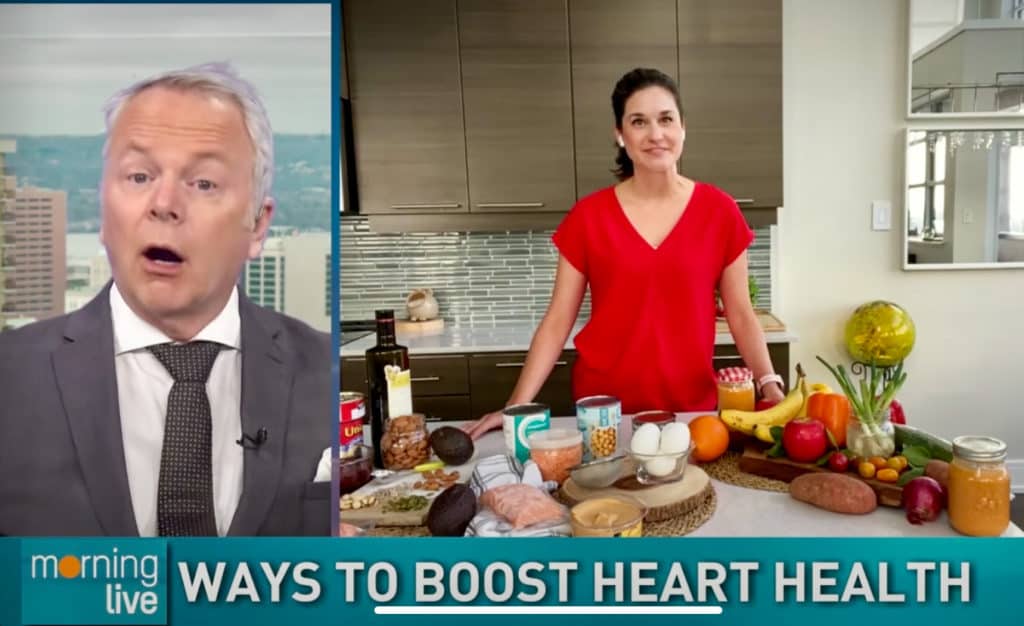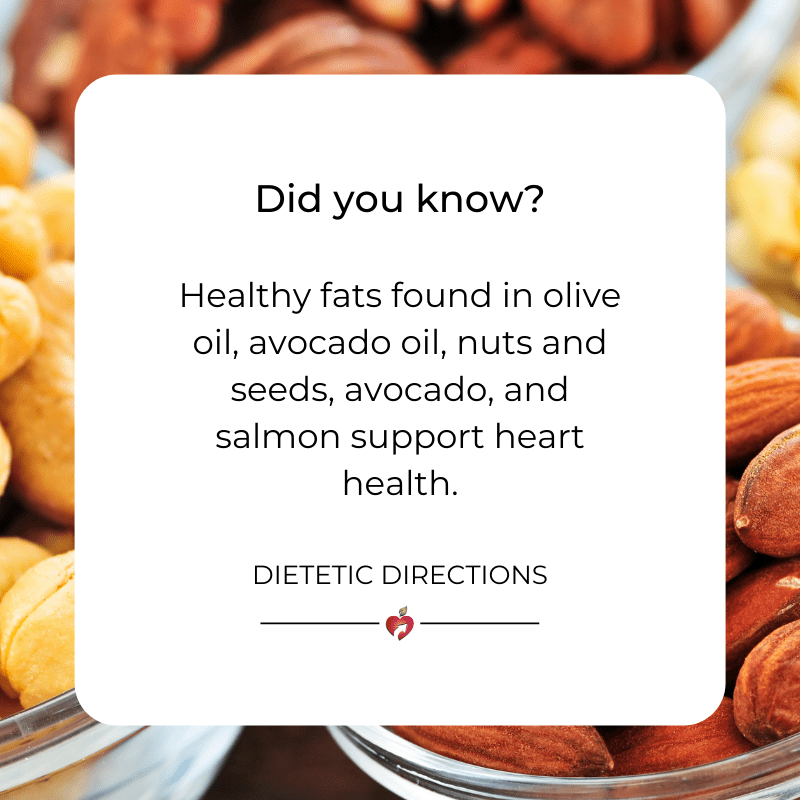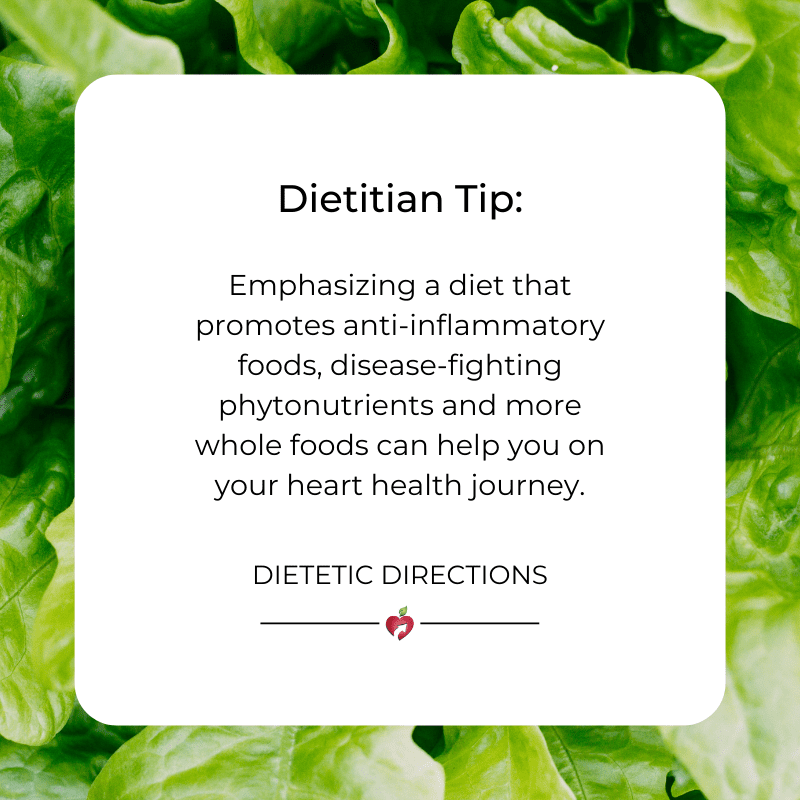
Ways to Boost Heart Health
{Science-Based Tips & Tricks}
February is Heart Month. Today, we’ll explore science-based ways to boost your heart health. After all, your heart has been ticking before you were even born. However, we don’t often stop to think about our heart health until something goes wrong – such as a new diagnosis of hypertension, high cholesterol, or diabetes (all risk factors for heart disease) or a sudden event like a heart attack or stroke. Nevertheless, prevention is key since it’s estimated that 80% of cases of premature heart disease and stroke could be avoided with lifestyle and dietary improvements.

The goal of today’s blog is to empower you with a multitude of strategies to boost your heart health. Without further ado, let’s explore healthy changes you can incorporate TODAY to reduce your risk of heart disease tomorrow. Additionally, as with any dietary/lifestyle change, be sure to focus on sustainability and start from where you are today. So view change like going up a ladder. This helps to build and grow with incremental changes instead of trying to do a flying leap to the top of the ladder.

How Common is Heart Disease?
Heart disease is the 2nd leading cause of death in Canada and the primary leading cause of death in the United States. Heart disease occurs from the buildup of plaque in the arteries, which reduces blood flow to the heart. This may lead to a heart attack, heart failure, or even death.

live with diagnosed heart disease.
What are Heart Disease Risk Factors?
Possible risk factors of heart disease include: high blood pressure, high cholesterol, diabetes, sleep apnea, inadequate physical activity, unhealthy diet, excessive alcohol or recreational drugs, etc. Additionally, there are uncontrollable risk factors like age, gender, family history and ethnicity. Nevertheless, it’s important to know your risk factors so you can manage your health the best you can. Here’s an online tool for assessing your cardiovascular risk factors.
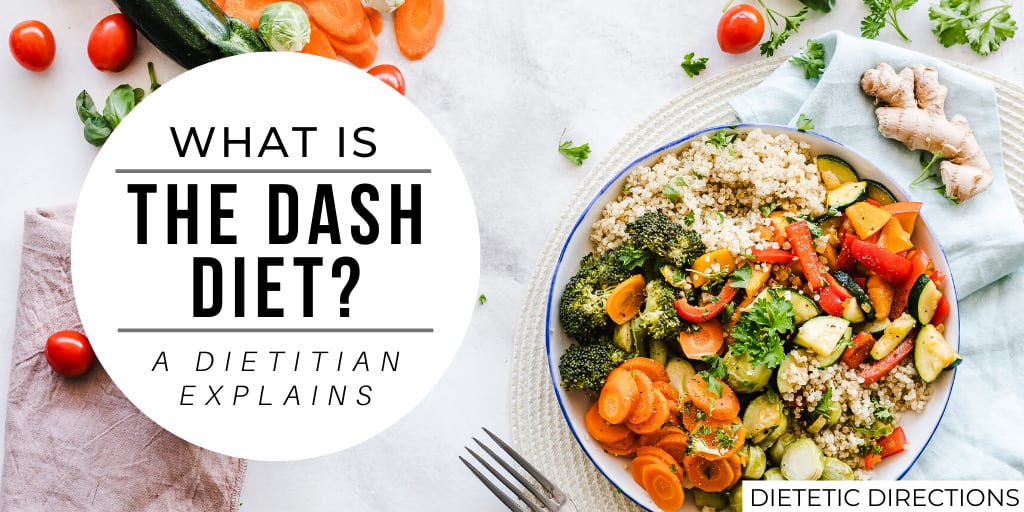
What about LDL Cholesterol?
LDL is a type of cholesterol that is often deemed the “L for Lousy” cholesterol. Your LDL cholesterol can lead to plaque formation in the arteries which is the most common form of heart disease (known as atherosclerosis). However, the problem occurs when LDL particles penetrate the arterial walls and become damaged (or oxidized). An immune response and subsequent inflammation results, forming plaque. The size and number of your LDL particles will impact the risk of them becoming oxidized. However, research finds dietary and lifestyle factors can help.
3 Science-Based Strategies to Boost Heart Health
1. Eat More Veggies & Fruit
Did you know that you can reduce your risk of heart disease and stroke by increasing the number of vegetables and fruit servings? Yes you can! These plant-based foods contain antioxidants that can help slow or prevent plaque from building in the arteries. This is because an antioxidant-rich diet can fight free radicals (which form from our breathing, diet, environment or stress.) These can travel throughout the body damaging cells and triggering an immune response leading to plaque formation. Not only does a veggie-rich diet provide antioxidants, but it also supports nutrients that help to reduce the risk of obesity, diabetes, cancer and respiratory disease.

Increasing your colourful food intake could benefit many of us since only 3 in 10 Canadians eat enough fruits and vegetables (Dalhousie University’s Agri-Food Analytics Lab Research.) From a nutrition perspective, these vibrant plant wonders often pack vitamin A (like beta-carotene), antioxidant vitamin C, heart-healthy B vitamins, potassium and magnesium along with varying amounts of fibre, which all help to reduce cholesterol and plaque buildup in the arteries.
What’s the Research Say?
Research reveals an inverse linear relationship between vegetable variety and the prevalence of heart disease (ref, ref, ref). In fact, the EPIC-Heart Study followed over 300,000 men and women without heart disease or stroke for more than eight years. They found that individuals who ate at least eight servings of vegetables and fruit a day had a 22% lower risk of dying from heart disease than those who consumed fewer than three servings a day. Notably, the results were adjusted for smoking, alcohol intake, body-mass index, physical activity, marital status, education, employment, high blood pressure, angina, diabetes and total calorie intake.

How Many Veggies Should We Consume Daily?
Canada’s Food Guide recommends adults consume about 7 to 10 servings of fruits and vegetables daily. Without a doubt, this can be a real challenge. However, research supports a heart disease risk reduction by as much as 11% for each serving of vegetables and fruit added per day. Stay tuned for tips below on how to boost your intake and heart health.

Additionally, research found that consuming MORE than three servings of fruits and vegetables per day can lower triglycerides by approximately 0.10 mmol/L and diastolic blood pressure by approximately 2 mmHg on average when compared to consuming less than three servings. Let’s bump up those veggies for your ticker!
What’s a Fruit or Vegetable Serving?
Be sure to count one serving as 1 cup raw vegetables, ½ cup cooked or a medium-sized fruit. Aiming to have two servings (or a double handful) of vegetables at meals or filling half your plate with veggies can help you hit this daily target. Also, keep in mind that antioxidant-rich foods contain a matrix of vitamins, nutrients and phytochemicals like flavonoids, which don’t often come in supplements. So go food first! Speak to a dietitian if wondering about vitamin supplements.
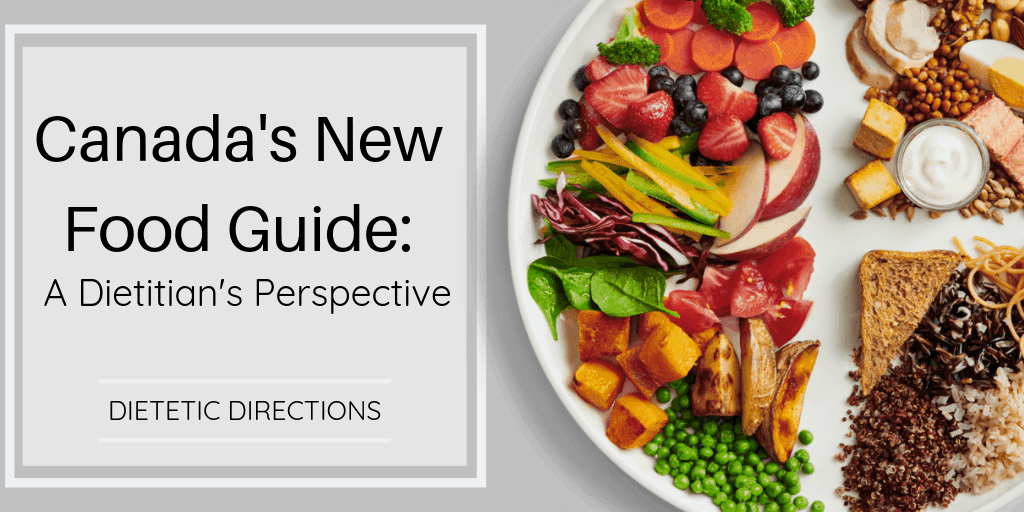
Here are specific actions to help reduce your risk of heart disease:
Veggie-Boosting Action:
- Take an inventory of how many veggies you are currently consuming. Self-awareness is key in behaviour change. In other words, understanding your WHY for making this change will help with perseverance.

- From where you are today, add ONE MORE veggie/fruit serving a day at a specific meal or snack. Therefore, this could mean adding side of carrot sticks to lunch, grilled zucchini or a homemade broccoli soup to dinner.
- Alternatively, you might begin adding a side salad to dinners to boost your intake or aim for two different veggies (or fruit) at dinner to promote higher consumption.
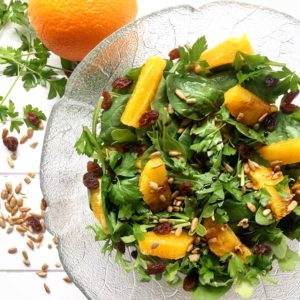
This Orange,%20Parsley%20&%20Sunflower%20Salad is a great way to boost your fruit and vegetable intake.
- Improve convenience: pre-cut veggies so they’re easier to incorporate at meals or snacks.
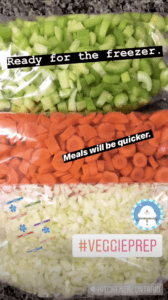
Andrea’s veggie prepping for freezer!
- Utilize frozen fruits and vegetable as versatile and nutritious alternatives. Try adding frozen fruits to oatmeal, smoothies, and yogurt parfaits. Find out the nutrition of frozen vegetables and canned vegetables.
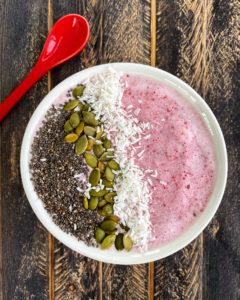
Looking to switch up your breakfast? Try this delicious Strawberry Banana Smoothie Bowl!
- Batch-cook veggie-rich meals like Chili, Quiche, or Soups to boost your intake during busy times when you aren’t cooking.

Grandma’s Mushroom, Broccoli & Cheddar Quiche is the perfect batch meal to boost vegetable intake on days you’re busy.
- Add veggies and/or fruit to your snack (see snack ideas here). Or enjoy a fruit parfait for dessert or an evening snack.
- Take advantage of sales and seasonal produce – for more tips on eating well on a budget or for seasonal foods check out our blogs.
- Vary your veggie cooking method– sautéed kale or rapini is a nice side-dish or perhaps with the winter, you’d like to roast some cauliflower to boost your intake and provide your heart with plaque-busting nutrition.

Parmesan and Oregano Roasted Cauliflower makes a delicious snack or addition to soups and sauces.
- Take a look at your plate and aim for half your plate with fruits and veggies according to Canada’s Food Guide recommends. Also, check out our past blog with my Dietitian Review of the newest Food Guide.
- Make them taste good! A common reason people don’t consume their veggies is that they don’t like the taste. Or try a cooking class if you would like to gain more confidence and skill in the kitchen.

- Eat at least one dark orange vegetable or fruit each day. Orange vegetables contain antioxidants called “carotenoids” (form of vitamin A) that give that beautiful red, orange and yellow colour. They’re also rich in vitamin C, potassium (which help regulate blood pressure) and folate, which supports our body’s cells. Examples include: carrots, sweet potato, cantaloupe, oranges and squash.

- Additionally, aim to eat at least one dark green vegetable each day. This is to help boost antioxidant intake as well as nutrients such as: folate, iron, magnesium, and potassium. Examples include: spinach, romaine lettuce, broccoli, rapini, arugula, parsley, etc.
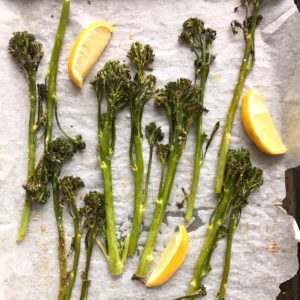
2. Choose Unprocessed Proteins
Protein is essential for our body’s functioning. In fact, this main macronutrient not only supports muscle repair and rebuilding. It also aids in hormone production, supports satiety or the feeling of fullness, which even appears to be helpful in fat loss. However, what might be less talked about is how our protein choices impact our risk for heart disease!
How to Choose Proteins that Boost Heart Health?
When choosing heart-healthy proteins, research supports the benefit of replacing processed, high fat, cured meats (like bacon, sausage, SPAM, deep fried wings) with unprocessed proteins such as: Fish, beans/ legumes, eggs, nuts, poultry, and low fat dairy to prevent heart disease. In fact, two of the most popular science-based diets for reducing risk of heart disease are the Mediterranean Diet and the DASH Diet. Both of these diets include moderate amounts of heart-healthy proteins such as lean poultry, fish, seafood, eggs, low fat dairy and beans/legumes to reduce risk for stroke and heart attack.
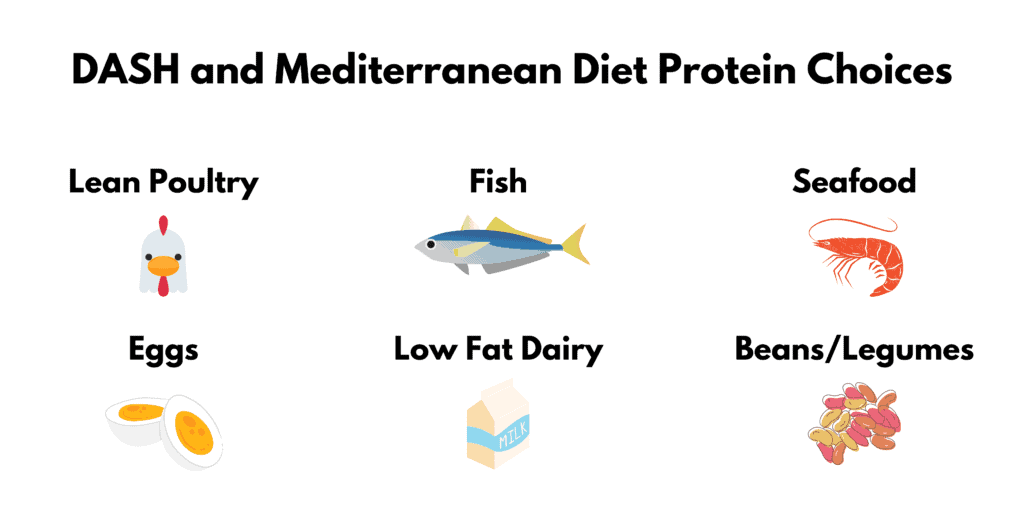
Impact of Eggs on Cholesterol?
Before we go further, let’s first debunk a common misconception that eggs increase blood cholesterol. This nutritious wonder has been given a bad rap for far too long. Fortunately, that’s clearing up as research continues to reinforce that dietary cholesterol has no meaningful impact on blood cholesterol. We have even seen Health Canada and the American guidelines relax their focus on cholesterol and shift into maligning foods high in saturated and trans fats which appear to increase blood cholesterol.

Interestingly, what’s often overlooked is that our livers produce 80% of our cholesterol and will adjust the amount produced based on our diets. This means that we can still enjoy whole foods (like eggs), which have cholesterol in them, but our liver will make less. We also want to look at the entirety of our meal – bacon will have a different impact on heart health compared to Hard-Cooked Eggs with Avocado Toast and a drizzle of olive oil.
Go for Less Processed!
A diet that is less processed and with less take-out is generally healthier. This means it’s higher in antioxidants, healthy fats along with vitamins and minerals. As a dietitian, I often recommend cooking at home to help in making more wholesome choices (here are some tips on meal planning).
Therefore, to improve your protein choices, focus on improving the convenience of these foods. I always batch-BBQ chicken for example and have freezer options to add to meals. Additionally, I have a batch-prep of hard-cooked eggs in my fridge to easily add to meals or snacks (see blog on what’s in dietitian fridge, freezer, pantry). Eggs are not only an excellent source of high-quality protein (6 grams per egg and only 70 calories) but they also contain 14 essential nutrients like Vitamin A (antioxidant lutein for eye health), selenium for heart health, and choline for brain functioning. For example, having frozen fillets of salmon in the freezer, canned beans, or lentils along with roasted, unsalted nuts in the pantry all make it easier to include them in your diet..
How Much Protein Do We Need?
As a general principle, aim for a serving of protein at each meal. When referencing Canada’s New Food Guide (click here for my Dietitian Review of the new Canada Food Guide), this could look like a quarter of the plate filled with wholesome, heart-healthy protein options like fish, eggs, lean meats (turkey, chicken, lean beef and pork), beans, lentils, nuts/seeds, edamame and soy products, etc. Or a serving of meat or fish should look size of your palm. If referencing the total grams of protein at a meal, a general target is around 30 grams per meal.
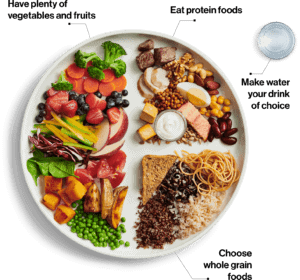
How Many Grams of Protein Per Day?
If you are into calculating protein needs, this number will depend on your weight, health goals and level of physical activity. A very general estimate is a range from 1.2–1.8 g/kg of body weight. Speaking with a Registered Dietitian is recommended for your personal protein target and how to meet this with meals and snacks. Historically, protein requirements have been extremely low using the Recommended Dietary Allowance (RDA) for protein of 0.8 g/kg. Contrary to popular belief, the RDA doesn’t represent an ideal intake; instead, it represents the minimum intake needed to prevent malnutrition.
Here are some specific, science-based actions to boost heart health:
Healthy Protein Choosing Tips:
- Choose protein-rich foods at each meal and emphasize ones with minimal processing such as lean meats, fish, eggs, legumes and soy.

- Incorporate dried, canned, or frozen beans, lentils or chickpeas into sauces, casseroles, soups or stews at least three times a week. Be sure to rinse canned beans and try new options like frozen edamame or lupini beans! Also, fibre in beans helps with lowering blood cholesterol, which is a risk factor for heart disease.
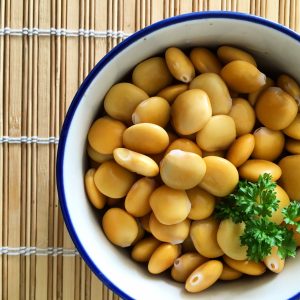
- Batch-prep hard-cooked eggs since they last in the fridge for a week and are ideal to add to meals or snacks.
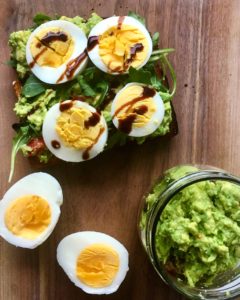
- Next, limit protein foods high in saturated fat such as processed and deep fried meats, fatty meats, full fat milk products, lard, and hydrogenated margarines.
- Modify cooking methods by poaching, roasting, steaming, grilling, baking and sautéing instead of deep frying.

- Aim to eat fish 2 to 3 times each week, particularly oily fish like salmon, herring, mackerel and rainbow trout. Canned salmon or frozen fillets are convenient to stock up on.

- Include heart-healthy protein-rich foods at your snacks. Examples include: ¼ cup of unsalted nuts or seeds, hard-cooked eggs, roasted chickpeas, hummus, peanut butter or lower fat yogurt.

- Prep lunches ahead such as a bean or lentil salad to boost fibre and heart-healthy magnesium in your diet.

- Buy chicken in bulk when it’s on special and freeze it into smaller portions so you can use it when you need to. Can also batch grill chicken, slice and place in the freezer.
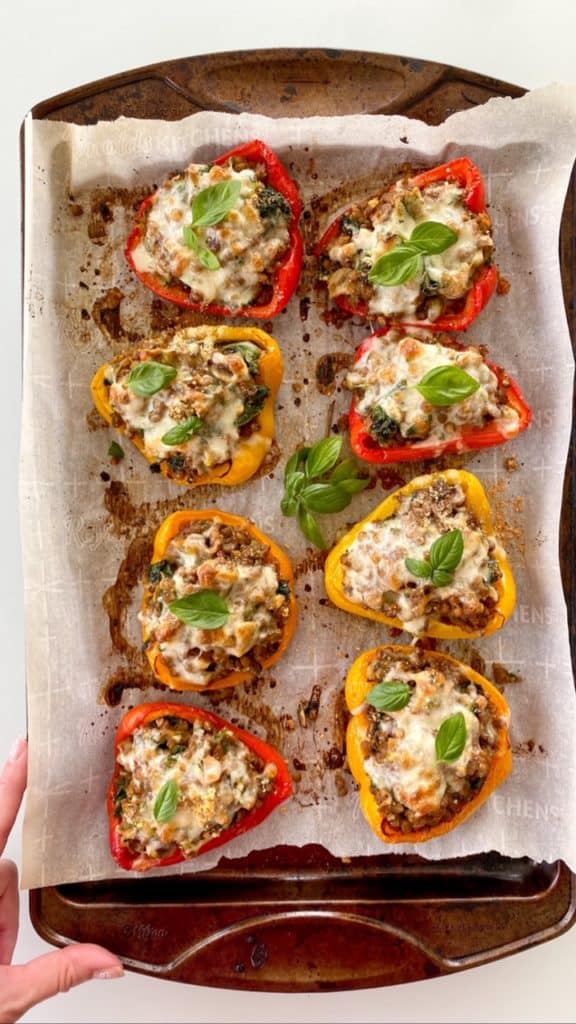
- Use a Meal Theme such as Breakfast for Dinner, Taco Tuesday or Fish Friday to help you meet health goals. This sparks creativity and decreases meal possibilities. For the Breakfast for Dinner theme I love options like: omelettes, egg sandwiches, French toast, shakshouka, mini egg muffins, etc.
3. Choose Healthy Fats
Finally, another science-based tip to boost heart health is to emphasize anti-inflammatory fats – these include monounsaturated fats (like olive oil, avocado oil, nuts and seeds, avocado) along with polyunsaturated fats in fatty fish like salmon, trout, mussels, squid, mackerel. These types of fats are considered beneficial because they can improve cholesterol, decrease inflammation, and stabilize heart rhythms. These foods also provide nutrients and vitamins or antioxidants to support our body cells – like vitamin E, vitamin A and magnesium.
What’s the Research Say?
Research of 54 Randomized Controlled Trials (lasting 3 to 27 weeks) found that oils higher in poly- and monounsaturated fats had more favourable effects on LDL cholesterol and total cholesterol compared to those higher in saturated fats. The Mediterranean Diet and DASH Diet both emphasize anti-inflammatory fats. These diets also emphasize dietary patterns rather than single nutrients tested in isolation. This is an important distinguishing characteristic since we eat FOOD and not single nutrients.
Is All Saturated Fat Bad?
The take-away from saturated fat is that we need to look at the big picture. Because a food contains saturated fat, it does not mean this is necessarily detrimental to our heart health. In other words, the specific food is more important than the type of fat it contains. When looking at the dietary context, ask yourself if the foods are nutrient-rich, are they unprocessed and how is your portion? There is also research to suggest that including saturated fats can help with increasing the particle size of your LDL cholesterol making them less prone to oxidization, which forms plaque. We will have to stay tuned as the research evolves. In the meantime, we should focus on what we already know about foods that appear to be helpful for reducing heart disease risk.
How Much Fat Do We Need?
Importantly, be sure to include a fat source at ALL of your meals. This could mean having a couple tablespoons of unsalted nuts or seeds on your oatmeal or high-fibre cereal in the morning. Or adding half an avocado to your sandwich, drizzling a tablespoon of olive oil on your salad at dinner. Fats are necessary for our body functioning. So think of fats from a positive lens and with a smaller portion in mind.
Here are some specific, science-based actions to boost heart health:
Actions for Anti-inflammatory Fats:
- Use olive oil, avocado or canola oil for salad dressing as a source of monounsaturated fats.

- Include nuts or seeds (around ¼ cup per day) as part of meals or snacks. Include a variety such as walnuts, almonds, hazelnuts, sunflower seeds, peanuts, etc.

- Have fatty fish in your diet two to three times a week.

- Include peanut butter or seed butters with smoothies, sandwiches or baking.
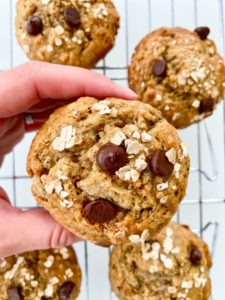
- Mash in avocado to tuna-salads or devilled eggs for a healthy fat boost.

- Add an olive oil drizzle on ricotta toasts, avocado toasts or hard-cooked eggs.

- Avoid only focusing on saturated fat (or on any one nutrient) and look at the foods that provide it and beyond that, your overall diet and lifestyle.
- Cook more at home, choose less processed or packaged foods. Use Meal Themes, Meal Planning, and try packing your own lunch.
Don’t Miss the Forest From the Trees!
A lot of heart health nutrition comes down to the BIG picture. Oftentimes, clickbait nutrition headlines and new studies released daily with sensationalized findings can shake the public’s confidence. Therefore, when it comes to modifying your diet and lifestyle to reduce the risk of heart disease, keep calm and think of your entire diet and lifestyle. What are your meals like and could they be improved? How is your stress level? Are you physically active?
Bottom Line:
Heart Month is a time to check in on your nutrition and its impact on your good ol’ ticker. The build-up of plaque in our arteries is a leading contributor to Heart Disease and often preventable with diet and lifestyle changes. Therefore, emphasizing anti-inflammatory foods, disease-fighting phytonutrients and less processed (or whole foods) can help in this journey. Be sure to also take care of mental health for stress management and incorporate physical activity into your daily routine. Finally, even though we are still in COVID times, check-in with your doctor for routine bloodwork and know your current risk factors like blood pressure, cholesterol, triglycerides and blood sugar.
What are your Heart-Healthy routines you want to implement this month? How will you be consistent in these?
